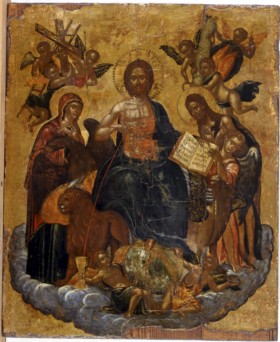IV.1á. Society and art in Venetian Crete
Around 1453, after the fierce clashes of the 13th and 14th c., a modus vivendi had been reached between the Venetian conquerors and the native Cretan aristocracy. While the situation of the lower classes was tending to get worse as time went by, the mixed (Veneto-Cretan) upper social strata which emerged maintained direct links with Venice and created cultural products of high artistic value from the mid 15th c. onwards. In the 16th and 17th c., after three centuries of the Venetian presence on the island, structures had been created, which on the one hand were reminiscent of Western European feudalism and/or the former Byzantine regime, and on the other resembled those of contemporary Italian city states. The art of Venetian Crete appropriated both Byzantine and Late Gothic forms, often combined with Renaissance or Baroque elements. It was a clear reflection of a society with a variety of reference points, balanced between the Middle Ages and Modern era.
-

Icon with J H S
BXM: 001549
Exhibition room: IV.1á Society and art in Venetian Crete
details -

Icon of St John the Baptist
BXM: 001551
Exhibition room: IV.1á Society and art in Venetian Crete
details -

Icon of the Dormition of St Onoufrios
BXM: 002041
Exhibition room: IV.1á Society and art in Venetian Crete
details -

Icon with an Allegory of the Holy Communion
BXM: 002221
Exhibition room: IV.1á Society and art in Venetian Crete
details -

Saint Theodore Tiro
BXM: 013059
Exhibition room: IV.1á Society and art in Venetian Crete
details -

The Three Hierarchs
BXM: 013098
Exhibition room: IV.1á Society and art in Venetian Crete
details








